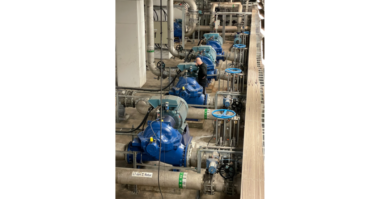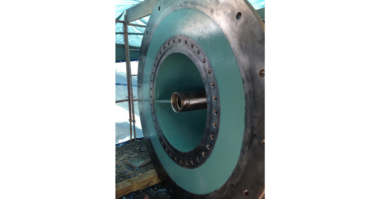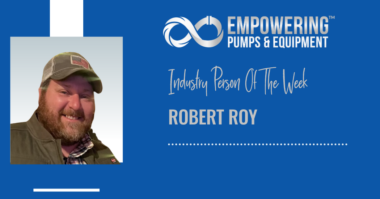In this post on double seals, Part 4, AW Chesterton discusses how to choose the type of barrier / buffer fluid that is best for your double seal application.
[So far in their Double Seals series, they addressed the overall benefits of double or dual seals (Part 1); various set-up configurations (Part 2); and double seal support systems (Part 3).]
Double Seals & Fluid Options
Because double seals allow for a fluid between the inboard and outboard faces, you can modify the operating environment of the seal and extend its useful life.
Noted earlier in this series, there are two modes of double seal operation to choose from depending on your sealing goals:
- Barrier Fluid (Pressurized): Fluid set at a pressure 1-2 Bar (15 – 30 Psi) higher than the process fluid. When the fluid is provided as a barrier fluid, it will displace the sealed fluid across the inboard seal, and lubricate the seal faces.
- Buffer Fluid (Unpressurized): Fluid set at a lower pressure than the process fluid.
This choice ties in with the dual seal configuration and the piping plan used, addressed in Part 3 of this blog series.
In double seals, buffer / barrier fluids are necessary to:
- Provide lubrication
- Remove process and frictional heat
- Combat issues associated with cavitation and dry running
- Prevent process media from causing damage to the inboard mechanical seal faces by being pressurized 1 to 2 Bar g (14 – 28 psig) above the sealing chamber pressure
Choosing the “Best” Fluid
What is the best barrier / buffer fluid? The answer depends on the operating conditions and the process fluid being sealed.
The most suitable fluids will have the following properties:
- Compatible with the process media – #1 concern!
- Compatible with the seal and storage tank materials
- Does not contain hazardous, harmful, or regulated pollutants
- Non-flammable
- Safe to store, handle, and use
- Stable at ambient temperature
- Good rates of flow at the required operating temperatures
- Non-foaming or gas absorbing
- Excellent lubricity for the selected seal face materials
- Good rates of heat transfer
Water
There are several benefits associated with using water as a barrier or buffer fluid:
- Thermal conductivity: Water’s thermal conductivity is around three times greater than that of oils, and it has double the specific heat. This makes water an excellent fluid for transporting heat away from mechanical seals.
- Material compatibility: There are little or no material compatibility issues with fresh water: it is easy to store and handle, and is relatively inexpensive.
- Fluidity: With a kinematic viscosity of 1 centistoke at 70°F (21°C), water flows well in systems which have mechanical seals that are not equipped with pumping rings.
Water is the ideal buffer/barrier fluid as long as it is compatible with the fluid being sealed. For example, we would not use water as a barrier fluid if we were sealing a strong acid. In this situation, if the water leaked into the acid due to an inboard seal failure, it may cause a dangerous reaction.
Temperature Considerations with Water
![AW Chesterton How to Select the Best Barrier Buffer Fluid [Double Seals Part 4] (2)](https://empoweringpumps.com/wp-content/uploads/2023/08/AW-Chesterton-How-to-Select-the-Best-Barrier-Buffer-Fluid-Double-Seals-Part-4-1.png)
Figure 1
- Elevated Temperatures: Water’s viscosity decreases at high temperatures, limiting its usefulness as a lubricant. Often we mix water with Propylene Glycol 50/50 to prevent the water from boiling and allow the fluid to absorb heat generated by the seal and the process.
- Cold Conditions: Care must also be taken to prevent freezing. In lower temperature service, Propyl Alcohol has been mixed with water to lower the freezing temperature of the buffer/barrier fluid. This allows the buffer/barrier fluid to be pumped though the seal by its pumping ring.
Oils
![AW Chesterton How to Select the Best Barrier Buffer Fluid [Double Seals Part 4] (2)](https://empoweringpumps.com/wp-content/uploads/2023/08/AW-Chesterton-How-to-Select-the-Best-Barrier-Buffer-Fluid-Double-Seals-Part-4-2.png) Oils offer several benefits compared to water:
Oils offer several benefits compared to water:
- Greater thermal stability at elevated temperatures compared to water
- Less likely to freeze
- Exceptional lubrication to the mechanical seal faces
- Fewer compatibility issues
NOTE: The use of oils with carbon seal faces is not generally recommended. Some users of traditional automotive and transmission oils have experienced mixed results when using them as a barrier fluid. This is primarily because the complex mix of additives and modifiers included in these oils to increase performance in their intended applications. Good performance can only be achieved from paraffinic based oils with a viscosity below 32 centistokes measured at 40˚C (100˚F). Oils of a higher viscosity resist flow and can damage mechanical seal faces.
Still unsure of which fluid to use for your double seal needs? Contact AW Chesterton’s Ask an Expert service for assistance.

![AW Chesterton How to Select the Best Barrier Buffer Fluid [Double Seals Part 4] (2)](https://empoweringpumps.com/wp-content/uploads/2023/08/AW-Chesterton-How-to-Select-the-Best-Barrier-Buffer-Fluid-Double-Seals-Part-4.png)


